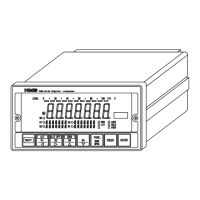19
5.
Calibration procedure
Warning ● Before using the new instrument or after exchanging the sensor with
new one, be sure to make calibration.
If calibration is not made, correct measured results may not be
obtained, nor it may cause malfunction to the instrument and it may
damage the peripheral equipment.
Moreover, even if calibration is made, there may occur the similar
case as above when the result is not correct. So make precise
calibration again.
● Calibration on the instrument are not interlocked with “Display value
at minimum analog output”(FUNC−17), and “Display value at
maximum analog output”(FUNC−18) when optional current
output(CSD814B−P07) and voltage output(CSD814B−P23, −P24,
−P25, −P26) are installed. When this option(s) is installed, be sure to
execute/check the setting of FUNC−17 and FUNC−18 at the time of
calibration is applied. If neglected, it may be the case that correct
output can’t be obtained or cause of malfunction, and also it may
cause a destroy in peripheral equipments.
5−1. Preparations
According to the section 4. Connection method, connect the instrument and strain gage applied
transducer properly and supply the power.
5−2. Calibration procedures
Followings are the load calibration procedures for the instrument.
1
After setting the load to zero (Initial load condition with tare weight), register the output of
strain gage applied transducer (conversion with mV/V) at the time of maximum display
(weighing value).
2
After completing the above calibration, fine adjustment mode that compensates the difference
of display when actual load is applied.
● In the calibration for ①, the accuracy is 1/1 000 or so.
In the following items, we will describe each calibration procedure by showing the examples
with the application of load cell.

